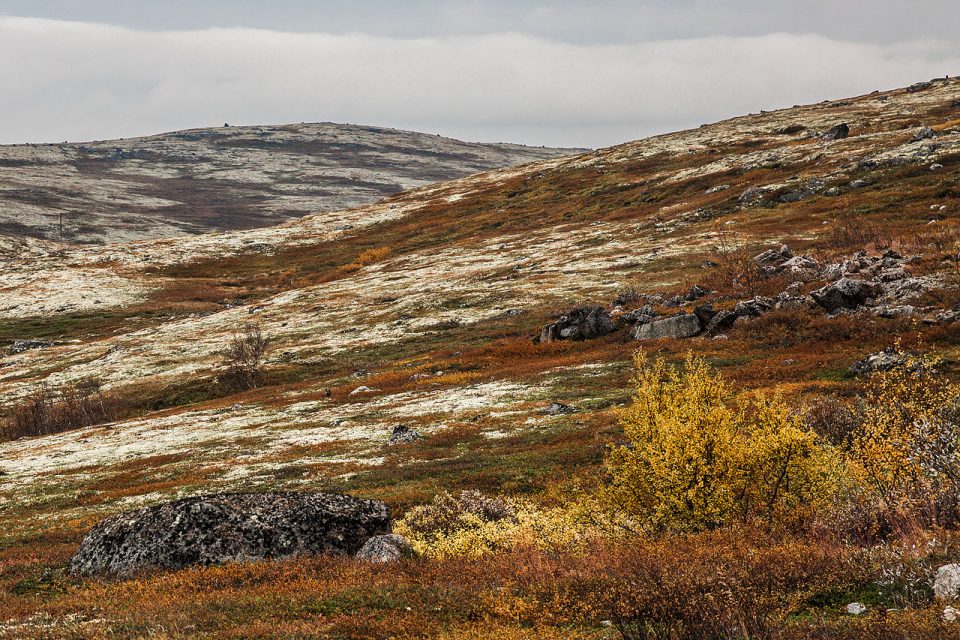
3 Unique Tundra Animals
Mountaintops, the Arctic region, and Antarctica are home to some very unique species of animals. These areas are all part of a biome (habitat type) called the Tundra, which is a lot like a frozen desert. There are many unique tundra animals.

Kola Peninsula, Russia
The tundra is a biome characterized by extreme cold, lack of rainfall, short growing season and lack of nutrients. The tundra has a permanently frozen layer of soil called permafrost. This frozen expanse may seem lifeless, but the animals that live in the tundra remain active despite these harsh conditions.
The extremes of the tundra force animals to adapt. Because of this, the tundra is home to many interesting and unique species. Read about a few of our favorites below.
American Pika (Ochotona princeps)

This pika has quite the harvest. Hopefully it doesn’t get stolen!
These small mammals look a lot like obese mice, but are actually more closely related to rabbits! They live in the alpine tundra (at the peaks of mountains over 6000 feet).
Pikas may be extremely cute, but they have a tough side too. They are known to participate in “kleptoparasitism” which is just a fancy word for stealing food. Pikas will raid their neighbors stashes of grass and chow down for themselves.
Their cute little faces are hiding this sneaky secret. In the harsh winters of the tundra, it’s every pika for itself. This adaptation means only the sneakiest pikas have enough to eat.
As the climate changes, pikas are one of the lucky species that has been able to adapt with it. There were concerns that rising temperatures would destroy essential pika habitat. However, a recent study has shown that pikas are expanding to new regions.
These cute little animals have to be careful when they explore. They provide an essential food source to arctic foxes in the sparse tundra.
Gyrfalcon (Falco rusticolus)

The gyrfalcon is one of the fastest animals in the world.
The gyrfalcon is the largest falcon in the world. These magnificent birds breed on the arctic tundra during the summer. During the cold winters, they migrate south from the arctic circle to warmer climes.
Nothing can outrun this formidable hunter. The gyrfalcon can reach speeds of up to 209 km/h (130mph). On average they fly 80-110km/h (50-68mph). This makes them one of the fastest animals in the world and certainly the fastest animal in the arctic tundra.
These falcons primarily hunt other birds. It’s most common pray is the ptarmigan. They will also eat small mammals such as arctic ground squirrels and arctic hares.
Musk Ox (Ovibos moschatus)

These musk ox are adapted to the harsh tundra.
The musk ox (or musk oxen) are enormous arctic mammals that live in large herds. Weighing 440-900 pounds at adulthood, these enormous beasts are about the size of a VW bug. They are known for their long beards, bony heads, and their distinctive, musky odor.
Musk oxen have long shaggy hair with a short, soft undercoat that helps them keep their body heat in during the cold Arctic winters.
Herds of Musk ox can be made of over 70 individuals, both male and female. Though they are large and strong animals, the young are hunted by wolves, polar bears, and grizzly bears. These large packs will protect their young by keeping them near the center of the pack. Fully grown Musk ox provide protection to the pack.
The tundra is a harsh biome that encompasses places as remote as the North Pole and Antarctica. These locations seem desolate and uninhabitable but are surprisingly full of life. The animals of the Arctic must survive harsh conditions. Evolution adapts to these extremes with some interesting and unique adaptations.












